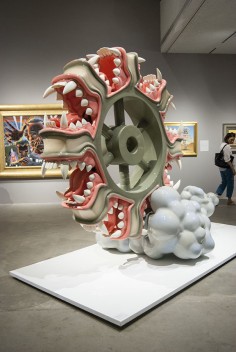ROBERT WILLIAMS

source: robtwilliamsstudio
In the late 20th and 21st centrury diverse forms of commonplace and popular art appeared to be coalescing into a formidable faction of new painted realism. The phenomenum owed its genesis to a number of factors. The new school of imagery was a product of art that didn’t fit comfortably into the accepted definition of fine art. It embraced some of the figurative graphics that formal art academia tended to reject: comic books, movie posters, trading cards, surfer art, hot rod illustration, to mention a few.
This alternative art movement found its most congealing participant in one of America’s most opprobrious and maligned underground artists, he painter, Robert Williams. It was this artist who brought the term “lowbrow” into the fine arts lexicon, with his ground breaking 1979 book, The Lowbrow Art of Robt. Williams. It was from this point that he seminal elements of West Coast Outlaw culture slowly started to aggregate.
Williams pursued a career as a fine arts painter years before joining the art studio of Ed “Big Daddy” Roth in the mid-1960’s. And as this position as the famous custom car builder’s art director, he moved into the rebellious, anti-war circles of early underground comix.
.
.
.
.
.
.
.
source: 2kqedorg
His paintings are a wild pop-culture pastiche of hot rods, pinup girls, and cartoon sex and violence. For the better part of the last 50 years, Robert Williams has waged war on the mainstream art world with those eye-popping paintings, a best-selling art magazine and a growing flock of like-minded rebel artists.
Now he’s the focus of a major L.A. retrospective — which at one time might have been a frightening, if not downright laughable, notion to some. The artist himself will be the first to tell you.
“My artwork would not be appropriate if your pastor was coming to dinner,” says Williams, sitting in the library of his home in a sleepy neighborhood of Chatsworth north of Los Angeles.
In a Robert Williams painting, there might be blood, fiery hot rod crashes or lecherous robots. There have also been surly tooth fairies in torn fishnets that bear a passing resemblance to Symbionese Liberation Army-era Patty Hearst.
Oh, and don’t forget that sexy and very funny series that depicts half-naked women reclining seductively on giant platters of tacos and enchiladas.
“There is gratuitous sex and violence in my work, and I defend that by saying artists should be responsible for the entire human pathos of life,” says Williams.
“A picture’s gotta have a lot of energy. You could start a car off of one of my paintings,” he laughs.
It was cars — hot rods to be exact — that drove a 20-year-old Williams to California from his native New Mexico in 1963.
“I was attracted to Los Angeles for hot rods. The other thing was girls,” he says, laughing. “I just had to get to California.”
While his canvases may boil over with surreal and slapstick eroticism, violence and psychosis, Williams is downright genteel and dapper in a crisp button-down shirt, navy-blue sweater vest and matching sneakers.
He speaks with a slight drawl left over from his days growing up in New Mexico and Alabama and a folksy earnestness that occasionally veers into Jimmy Stewart territory.
He can spend about as much time tinkering on those paintings as he does on his beloved candy-colored hot rod, a 1932 Ford Roadster. Alongside that is a pristine Model T, which he restored piece by piece with his wife, artist Suzanne Williams.
“Working on the cars is akin to masturbation,” says Williams. “That’s just something I have to do to get my mind off the art. But to me the art is a cerebral exercise.”
Williams bought the Roadster nearly 50 years ago, around the time he broke into the art world as an illustrator for Southern California hot rod magazines.
It’s where he’d get his footing as a professional artist. But he chafed at the rigid demands of advertisers and editors.
But in the pages of the ’60s counterculture underground comics, Williams flourished alongside like-minded artists who pushed the boundaries of free expression. He was a founding member of a San Francisco-based comic artist collective that also included Robert Crumb, Gilbert Shelton and the late Spain Rodriguez.
All the while, Williams toiled away on his paintings.
Problem was, there was little space for the kind of hot-wired, pop culture-drenched representational paintings he was creating in an art world dominated by abstract expressionism.
“And it was just looking hopeless, couldn’t get a gallery to show me, and finally I got involved with punk rockers.”
Williams found an outlet and acceptance in after-hours galleries at punk rock clubs in L.A. and New York. His art work started appearing on record sleeves and concert posters for bands that have mostly vanished. But mainstream success remained elusive.
Until 1987, that is. That’s when yet another then-unknown band came knocking on his door after spotting what is today considered Williams’ most notorious painting.
A scruffy L.A. glam rock band called Guns N’ Roses wanted it for the cover of its debut album. They also wanted to name the record after the painting: “Appetite for Destruction.”
In the painting, which Williams created in the late 1970s, a pretty young woman in a short skirt is selling toy robots on the street. Her kiosk is knocked over. So is she. A menacing robot in a trench coat stands over her.

